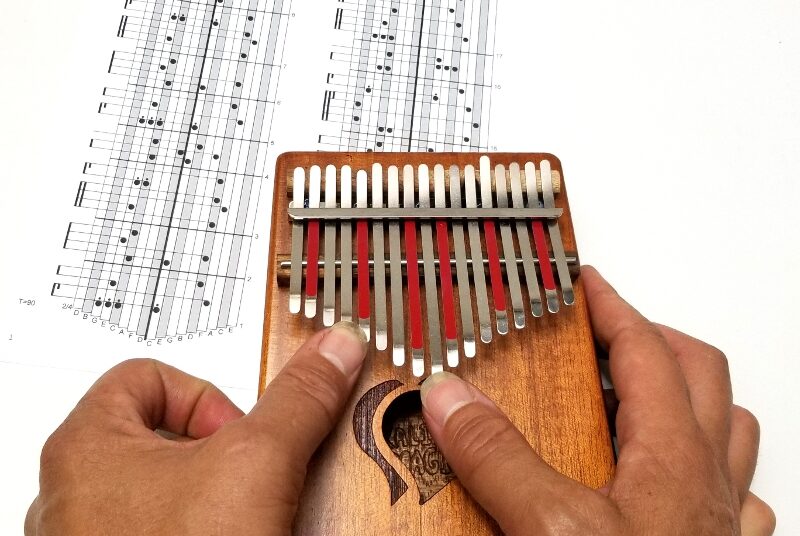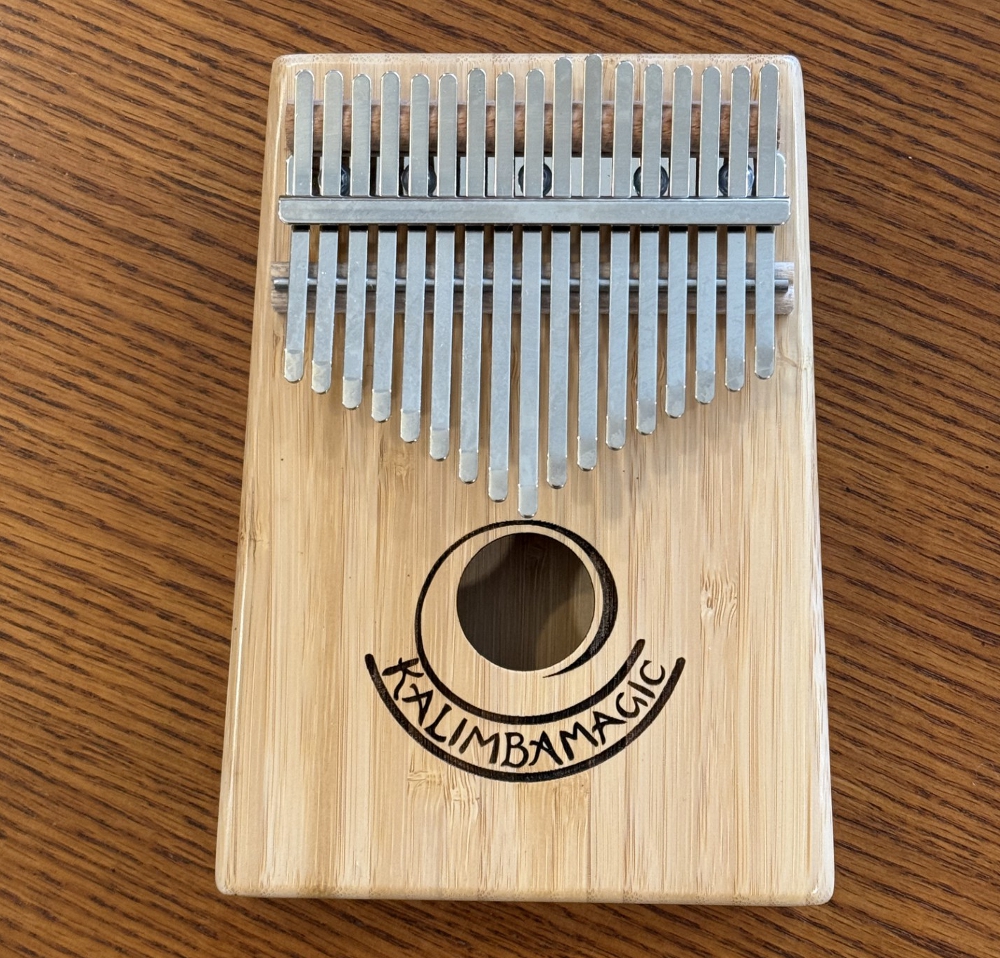
Use of this website constitutes acceptance of the Privacy Policy and User Agreement. Copyright © 2020 Kalimba Magic. All Rights Reserved.
The kalimba is fundamentally a polyphonic instrument – meaning it plays multiple notes at the same time. It does have more limitations in its ability to play multiple notes than, say, piano or guitar. But those limitations on the kalimba also make it very easy to make some very pretty music – for example, any two adjacent notes on one side will always harmonize. Three adjacent notes will always make some sort of triad, a sweet three-note chord.
But what about two notes on opposite sides of the kalimba? Will they sound good or bad when played simultaneously? It could go either way, but I have a very simple rule of thumb that will help you make sweet harmonies when playing notes or chords with both left and right thumbs.
Here is “Mark’s Rule of Thumb:” Don’t play two tines at the same time that are straight across the kalimba from each other. Those two tines will have almost the same length, and almost the same pitch, and when you play them together, they will sound dissonant or nasty. Well, it isn’t a hard and fast rule, because sometimes you will want that dissonance in your music. In general, and especially if you are a beginner, most of your dissonances will be unintentional. But there is a way to avoid it.
There’s another part to “Mark’s Rule of Thumb” – the converse of the first statement: “If you want sweet harmonies, pick your note on one side… and let it push away the note on the other side.” If you are playing a low note on the left side, try playing a middle high note on the right side. If you are playing in the middle of the right side, try playing either a low note or a high note, on the left side.
This rule works this way because (on all diatonic kalimbas with alternating note layouts) the low notes are duplicated an octave higher, up on shorter tines on the opposite side of the kalimba. This enables you to play a chord low down on one thumb, while the other thumb plays a high melody note.
Experiment (depicted in the above image): Pick any note on the left side, and for the duration of the experiment, that note will not change. Now ask yourself: “How will this note sound with the notes on the other side?” And now, systematically play each of the notes on the right side to see how each one sounds with your chosen left-side notes.
This is me experimenting with the harmonies as above.
There are just a couple of note pairs that will sound bad – represented in my picture with a “-” sign to the right. But I think every other pairing of notes sounds great. See for yourself. If you find a pair of notes that sounds especially sweet, remember it, and someday you will build a song that uses this magic pairing.
Flip the experiment over: now pick a note for your right thumb to play. How will it sound with each note on the left side? You can find out, by testing them yourself, one pair at a time. Again, there will be a couple of pairs that don’t sound good, but all the other pairs of notes will sound good.
So get this: let’s say your brain is totally disconnected from your kalimba playing, and you are randomly playing one note on the left with another random note on the right. For this 15-Note kalimba in our picture, on left and right respectively, you have between a 6 out of 8 or a 5 out of 7 chance of playing something that sounds good – or about a 75% chance of success.
Now, try this – randomly place your two thumbs on tines on their respective sides. Before you play, check to see if they are straight across from each other. If they are, move one of your thumbs either up or down, and then play. If you do this, you should get much closer to 100% sweet harmonies on the first day.
If you learn to utilize “Mark’s Rule of Thumb” in your improvisational playing, you will immediately sound as if you know what you are doing on the kalimba. This is a huge advantage.
But there is so much more you can do with the Rule of Thumb:

In the music above, we start on E on left and G on right. (Hey, if you have a kalimba in a different key, don’t worry – these basic motions are still totally applicable even if the note names are different.) It plays a sweet harmony. Once you have that harmony, you can lock it in for other pairs of notes. You see the next pair of notes is made by moving both left and right thumbs outward by one tine. You don’t have to stop there, you can keep going outward one tine at a time. Or two tines at a time. Or you could move both thumbs inward. All of those will make pleasing sounds.

In the tab above, we take another pair of notes. Both left and right thumbs start on F notes. You have just hit the Daily Double! These two F notes are in different octaves, a lower one and a higher one. And as you scoot both thumbs outward or inward by one tine at a time, you will keep on hitting octave pairs of notes.

Oh, and I just cannot contain my excitement! Here, we have combined the previous two bits of tablature. The left thumb starts out pretty high, so the right thumb starts out pretty low… plus, both left and right thumbs are playing two tines at the same time! To do that, place your thumb nail right in between the two tines it is to play, such that it is touching both of them. Slide off, and try to pluck them both equally. Not difficult!
But the cool thing here – the thumbs trade positions. The left thumb next goes low, and the right thumb goes high… you shift both thumbs over to the right, which makes one thumb go to lower tines, and the other thumb go to higher tines. And to get back to the last note at the top of the tablature, shift both thumbs back to the left.
I call this the Windshield Wiper Method, for obvious reasons… though there are some newfangled cars with different wiper movements from the classic, unified wiper motions reflected by my thumbs in this music.
If you have bought some of my instructional downloads, look at the tablature. You will see these techniques all over the place in the Level 2, 3, and 4 songs: Mark’s Rule of Thumb, Locked-in Harmonies, and the Windshield Wiper Method. These are among the most common of ways to add harmonies or otherwise embellish a song.
Please, familiarize yourself with these super cool and easy tricks. When you see them come up over and over again in the tablature, you will know exactly what is going on. You will not freak out, but will remember these simple thumb motion patterns, and you will figure out exactly which tines to play to make some really beautiful songs come alive.


Sign up for our newsletter and free resources with your email address:
We pinky promise not to spam you and to only send good stuff.
 Seek to Infuse Your Musical Moments With Beauty and Magic
Seek to Infuse Your Musical Moments With Beauty and Magic Kalimba Magic – We Give You The Tools You Need to Succeed
Kalimba Magic – We Give You The Tools You Need to Succeed Back in Stock! The Bamboo-17 Kalimba
Back in Stock! The Bamboo-17 KalimbaUse of this website constitutes acceptance of the Privacy Policy and User Agreement. Copyright © 2020 Kalimba Magic. All Rights Reserved.